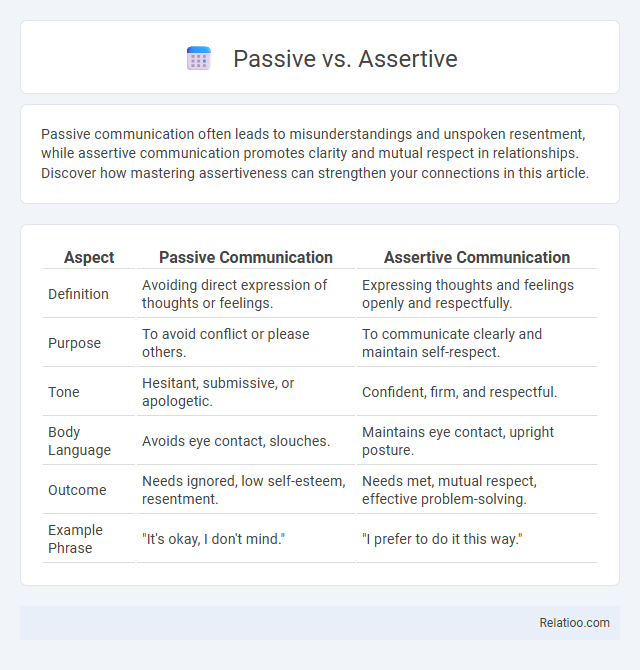Passive communication often leads to misunderstandings and unspoken resentment, while assertive communication promotes clarity and mutual respect in relationships. Discover how mastering assertiveness can strengthen your connections in this article.
Table of Comparison
| Aspect | Passive Communication | Assertive Communication |
|---|---|---|
| Definition | Avoiding direct expression of thoughts or feelings. | Expressing thoughts and feelings openly and respectfully. |
| Purpose | To avoid conflict or please others. | To communicate clearly and maintain self-respect. |
| Tone | Hesitant, submissive, or apologetic. | Confident, firm, and respectful. |
| Body Language | Avoids eye contact, slouches. | Maintains eye contact, upright posture. |
| Outcome | Needs ignored, low self-esteem, resentment. | Needs met, mutual respect, effective problem-solving. |
| Example Phrase | "It's okay, I don't mind." | "I prefer to do it this way." |
Understanding Passive and Assertive Communication
Passive communication often leads to unmet needs and suppressed emotions, while assertive communication emphasizes clear, respectful expression of thoughts and feelings. Understanding assertive communication empowers you to set boundaries confidently and foster healthier relationships by balancing self-respect with empathy. Mastering this dynamic improves your ability to navigate interactions without surrendering your own voice or provoking conflict.
Key Traits of Passive Behavior
Passive behavior is characterized by avoidance of expressing personal needs, difficulty saying no, and a tendency to prioritize others' desires over one's own. Individuals exhibiting passive traits often experience low self-esteem, suppress their opinions to prevent conflict, and may feel helpless or resentful. This behavior contrasts sharply with assertive and power dynamics, where clear communication and boundary-setting are essential for balanced interpersonal relationships.
Key Traits of Assertive Behavior
Assertive behavior is characterized by clear communication, confident body language, and respectful expression of thoughts and needs, distinguishing it from passive or power-driven interactions. You maintain control over your emotions while standing firm on your boundaries, promoting mutual respect and collaboration. The key traits include self-assurance, directness, and the ability to listen actively without dominating or yielding unnecessarily.
Psychological Impact of Passive Communication
Passive communication often leads to decreased self-esteem and heightened anxiety, as individuals suppress their needs and emotions to avoid conflict. This dynamic can result in feelings of helplessness and resentment, negatively influencing mental health and interpersonal relationships. Over time, persistent passive behavior reinforces power imbalances, reducing assertiveness and diminishing one's ability to advocate effectively for themselves.
Benefits of Assertive Communication
Assertive communication enhances your ability to express needs clearly while respecting others, fostering mutual understanding and reducing conflicts. This communication style promotes confidence and builds stronger relationships by balancing directness and empathy, avoiding the pitfalls of passivity or aggression. Practicing assertiveness improves problem-solving efficiency and encourages collaboration, leading to more productive interactions in personal and professional settings.
Common Misconceptions About Assertiveness
Common misconceptions about assertiveness include the belief that it means being aggressive or dominating others, which often leads people to confuse assertiveness with passivity or power plays. Assertiveness actually involves confidently expressing your needs and boundaries while respecting others' rights, balancing effective communication without undermining collaboration. Understanding this distinction helps you navigate social and professional interactions more authentically and empowers you to maintain healthy relational dynamics.
Real-Life Scenarios: Passive vs Assertive Responses
In real-life scenarios, passive responses often involve avoiding confrontation and yielding to others, which can lead to unmet needs and diminished self-esteem. Assertive responses clearly express your thoughts and feelings while respecting others, fostering healthy communication and mutual understanding. Recognizing these dynamics empowers you to handle situations confidently, avoiding the pitfalls of passivity or aggression in interpersonal interactions.
Barriers to Developing Assertiveness
Barriers to developing assertiveness often include fear of rejection, low self-esteem, and lack of communication skills, which may cause you to default to passive or aggressive behaviors. Power dynamics in relationships can further obscure your ability to express needs openly, as perceived imbalances can inhibit your confidence. Overcoming these obstacles requires recognizing internal biases and external pressures that limit assertive communication.
Techniques to Shift from Passive to Assertive
Recognizing passive behavior patterns such as avoiding conflict or suppressing opinions is essential for shifting towards assertiveness. Techniques like using "I" statements to express feelings clearly, practicing direct communication, and setting healthy boundaries empower Your voice and foster respect. Consistent self-reflection and role-playing scenarios help build confidence, gradually transforming passive responses into assertive interactions within power dynamics.
Choosing the Right Approach for Effective Communication
Understanding passive, assertive, and power dynamics is crucial for effective communication and conflict resolution. Your optimal approach depends on context; assertive communication balances respect and clarity, empowering you to express needs confidently without aggression or submission. Mastering when to employ passive restraint, assertive clarity, or power-based influence enhances relationship outcomes and decision-making effectiveness.

Infographic: Passive vs Assertive
 relatioo.com
relatioo.com